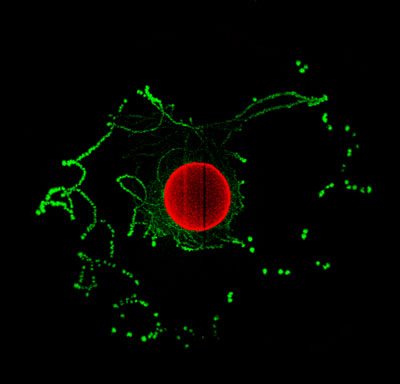C. elegans worms, a commonly studied model organism, carry and redistribute their bacterial food source as they forage and explore their environment. The food source can be exploited by any other individuals that arrive at the same locations and ‘harvest’ after the bacteria has grown. Thus worms engage in a primitive form of farming and public goods production. We demonstrate this in competing populations of farming and mutant, non-farming worms. In response to the increased availability of food, worms also increase their reproductive output. Our study is a combination of experiment and theory demonstrating that worms may optimize (i) their decisions to explore space and (ii) how they consume and protect and utilize their resources.

Figure: False-coloured image of the redistribution (green) of an initial patch of E. coli bacteria (red) by a foraging C. elegans nematode worm.
The problem of public good resources and other co-operative behaviors has long been studied, but these studies have primarily either been on microbial systems which are genetically tractable but lack any neuro-behavioral traits or on higher organisms such as primates with rich neuro-behavioral traits but where tractability is limited. Both C. elegans and E. coli are model organisms for which a vast array of genetic and neurobiological tools have been developed. We anticipate that the ideas presented in our work will pave the way to linking population level ecological and evolutionary dynamics with individual level genetic and neuro-behavioral factors using the interaction between these two powerful model systems.
The dynamics in our system have a striking similarity to a range of spreading processes in nature such as the dispersal of seeds, the carrying of commensal infectious agents by mobile vectors, or the composition of the locally inhabited ecologies. Empirical data in these cases is limited and, even when available it is observational rather than experimental. Our table top system allows careful and controlled investigations to test such spreading processes under diverse scenarios, for example, the effect of heterogeneous landscapes, of bacterial strains that are pathogenic to the worms, or even of bacterial strains that affect the mobility patterns of the worms by optogenetic and other methods.
The incidental dropping of food resources is not unlike the beginnings of agriculture - “ … people who gathered these [wheat] grains carried them back to their temporary campsites for processing … some of them inevitably fell on the way to the campsite and were lost. Over time, more and more wheat grew along favorite human trails and near campsites." [“Sapiens” by Yuval Noah Harari, - on p. 95]. The similarities to the phenomenon in our experiments are remarkable indeed.
Reference
Farming and public goods production in Caenorhabditis elegans populations. Shashi Thutupalli, Sravanti Uppaluri, George W.A. Constable, Simon A. Levin, Howard A. Stone, Corina E. Tarnita, and Clifford P. Brangwynne, Proceedings of the National Academy of Sciences of the United States of America, 114(9), 2289–2294, 2017 doi: 10.1073/pnas.1608961114.


































